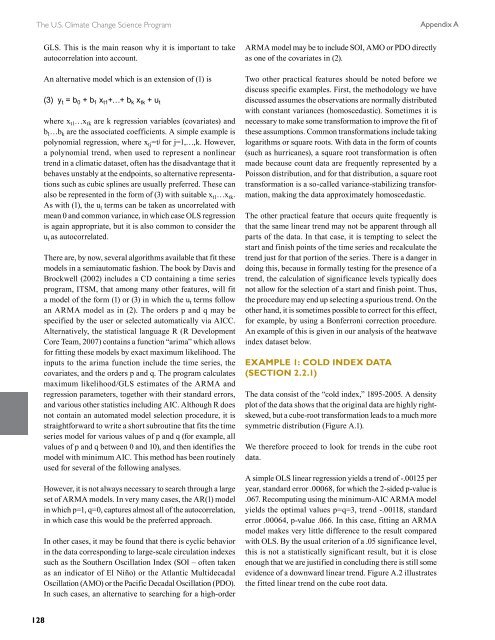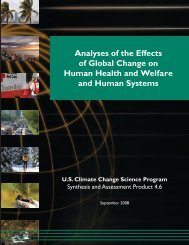Weather and Climate Extremes in a Changing Climate. Regions of ...
Weather and Climate Extremes in a Changing Climate. Regions of ...
Weather and Climate Extremes in a Changing Climate. Regions of ...
Create successful ePaper yourself
Turn your PDF publications into a flip-book with our unique Google optimized e-Paper software.
The U.S. <strong>Climate</strong> Change Science Program Appendix A<br />
128<br />
GLS. This is the ma<strong>in</strong> reason why it is important to take<br />
autocorrelation <strong>in</strong>to account.<br />
An alternative model which is an extension <strong>of</strong> (1) is<br />
(3) y t = b 0 + b 1 x t1+…+ b k x tk + u t<br />
where x t1…x tk are k regression variables (covariates) <strong>and</strong><br />
b 1…b k are the associated coefficients. A simple example is<br />
polynomial regression, where x tj=t j for j=1,…,k. However,<br />
a polynomial trend, when used to represent a nonl<strong>in</strong>ear<br />
trend <strong>in</strong> a climatic dataset, <strong>of</strong>ten has the disadvantage that it<br />
behaves unstably at the endpo<strong>in</strong>ts, so alternative representations<br />
such as cubic spl<strong>in</strong>es are usually preferred. These can<br />
also be represented <strong>in</strong> the form <strong>of</strong> (3) with suitable x t1…x tk.<br />
As with (1), the u t terms can be taken as uncorrelated with<br />
mean 0 <strong>and</strong> common variance, <strong>in</strong> which case OLS regression<br />
is aga<strong>in</strong> appropriate, but it is also common to consider the<br />
u t as autocorrelated.<br />
There are, by now, several algorithms available that fit these<br />
models <strong>in</strong> a semiautomatic fashion. The book by Davis <strong>and</strong><br />
Brockwell (2002) <strong>in</strong>cludes a CD conta<strong>in</strong><strong>in</strong>g a time series<br />
program, ITSM, that among many other features, will fit<br />
a model <strong>of</strong> the form (1) or (3) <strong>in</strong> which the u t terms follow<br />
an ARMA model as <strong>in</strong> (2). The orders p <strong>and</strong> q may be<br />
specified by the user or selected automatically via AICC.<br />
Alternatively, the statistical language R (R Development<br />
Core Team, 2007) conta<strong>in</strong>s a function “arima” which allows<br />
for fitt<strong>in</strong>g these models by exact maximum likelihood. The<br />
<strong>in</strong>puts to the arima function <strong>in</strong>clude the time series, the<br />
covariates, <strong>and</strong> the orders p <strong>and</strong> q. The program calculates<br />
maximum likelihood/GLS estimates <strong>of</strong> the ARMA <strong>and</strong><br />
regression parameters, together with their st<strong>and</strong>ard errors,<br />
<strong>and</strong> various other statistics <strong>in</strong>clud<strong>in</strong>g AIC. Although R does<br />
not conta<strong>in</strong> an automated model selection procedure, it is<br />
straightforward to write a short subrout<strong>in</strong>e that fits the time<br />
series model for various values <strong>of</strong> p <strong>and</strong> q (for example, all<br />
values <strong>of</strong> p <strong>and</strong> q between 0 <strong>and</strong> 10), <strong>and</strong> then identifies the<br />
model with m<strong>in</strong>imum AIC. This method has been rout<strong>in</strong>ely<br />
used for several <strong>of</strong> the follow<strong>in</strong>g analyses.<br />
However, it is not always necessary to search through a large<br />
set <strong>of</strong> ARMA models. In very many cases, the AR(1) model<br />
<strong>in</strong> which p=1, q=0, captures almost all <strong>of</strong> the autocorrelation,<br />
<strong>in</strong> which case this would be the preferred approach.<br />
In other cases, it may be found that there is cyclic behavior<br />
<strong>in</strong> the data correspond<strong>in</strong>g to large-scale circulation <strong>in</strong>dexes<br />
such as the Southern Oscillation Index (SOI – <strong>of</strong>ten taken<br />
as an <strong>in</strong>dicator <strong>of</strong> El Niño) or the Atlantic Multidecadal<br />
Oscillation (AMO) or the Pacific Decadal Oscillation (PDO).<br />
In such cases, an alternative to search<strong>in</strong>g for a high-order<br />
ARMA model may be to <strong>in</strong>clude SOI, AMO or PDO directly<br />
as one <strong>of</strong> the covariates <strong>in</strong> (2).<br />
Two other practical features should be noted before we<br />
discuss specific examples. First, the methodology we have<br />
discussed assumes the observations are normally distributed<br />
with constant variances (homoscedastic). Sometimes it is<br />
necessary to make some transformation to improve the fit <strong>of</strong><br />
these assumptions. Common transformations <strong>in</strong>clude tak<strong>in</strong>g<br />
logarithms or square roots. With data <strong>in</strong> the form <strong>of</strong> counts<br />
(such as hurricanes), a square root transformation is <strong>of</strong>ten<br />
made because count data are frequently represented by a<br />
Poisson distribution, <strong>and</strong> for that distribution, a square root<br />
transformation is a so-called variance-stabiliz<strong>in</strong>g transformation,<br />
mak<strong>in</strong>g the data approximately homoscedastic.<br />
The other practical feature that occurs quite frequently is<br />
that the same l<strong>in</strong>ear trend may not be apparent through all<br />
parts <strong>of</strong> the data. In that case, it is tempt<strong>in</strong>g to select the<br />
start <strong>and</strong> f<strong>in</strong>ish po<strong>in</strong>ts <strong>of</strong> the time series <strong>and</strong> recalculate the<br />
trend just for that portion <strong>of</strong> the series. There is a danger <strong>in</strong><br />
do<strong>in</strong>g this, because <strong>in</strong> formally test<strong>in</strong>g for the presence <strong>of</strong> a<br />
trend, the calculation <strong>of</strong> significance levels typically does<br />
not allow for the selection <strong>of</strong> a start <strong>and</strong> f<strong>in</strong>ish po<strong>in</strong>t. Thus,<br />
the procedure may end up select<strong>in</strong>g a spurious trend. On the<br />
other h<strong>and</strong>, it is sometimes possible to correct for this effect,<br />
for example, by us<strong>in</strong>g a Bonferroni correction procedure.<br />
An example <strong>of</strong> this is given <strong>in</strong> our analysis <strong>of</strong> the heatwave<br />
<strong>in</strong>dex dataset below.<br />
ExAMPlE 1: COlD INDEx DATA<br />
(SECTION 2.2.1)<br />
The data consist <strong>of</strong> the “cold <strong>in</strong>dex,” 1895-2005. A density<br />
plot <strong>of</strong> the data shows that the orig<strong>in</strong>al data are highly rightskewed,<br />
but a cube-root transformation leads to a much more<br />
symmetric distribution (Figure A.1).<br />
We therefore proceed to look for trends <strong>in</strong> the cube root<br />
data.<br />
A simple OLS l<strong>in</strong>ear regression yields a trend <strong>of</strong> -.00125 per<br />
year, st<strong>and</strong>ard error .00068, for which the 2-sided p-value is<br />
.067. Recomput<strong>in</strong>g us<strong>in</strong>g the m<strong>in</strong>imum-AIC ARMA model<br />
yields the optimal values p=q=3, trend -.00118, st<strong>and</strong>ard<br />
error .00064, p-value .066. In this case, fitt<strong>in</strong>g an ARMA<br />
model makes very little difference to the result compared<br />
with OLS. By the usual criterion <strong>of</strong> a .05 significance level,<br />
this is not a statistically significant result, but it is close<br />
enough that we are justified <strong>in</strong> conclud<strong>in</strong>g there is still some<br />
evidence <strong>of</strong> a downward l<strong>in</strong>ear trend. Figure A.2 illustrates<br />
the fitted l<strong>in</strong>ear trend on the cube root data.




